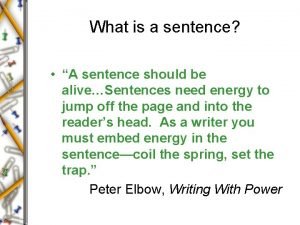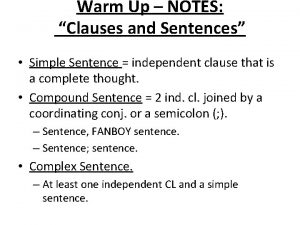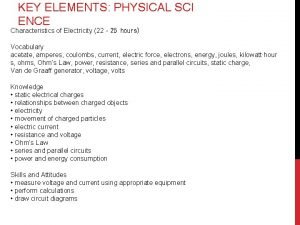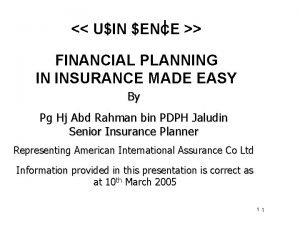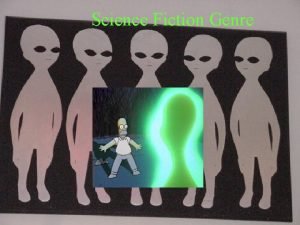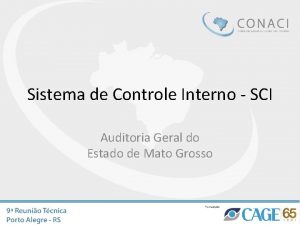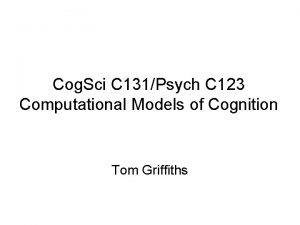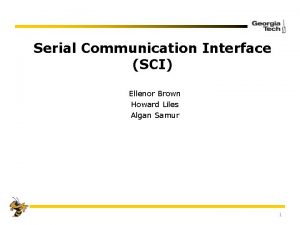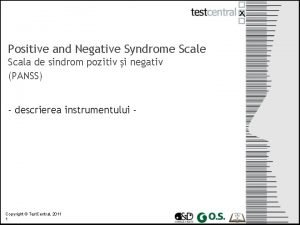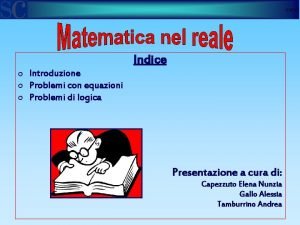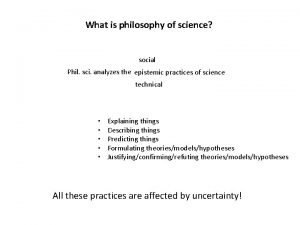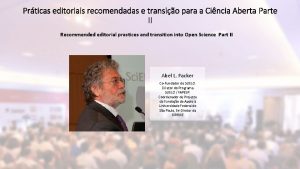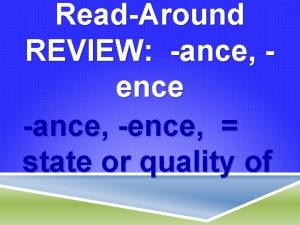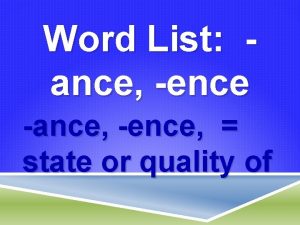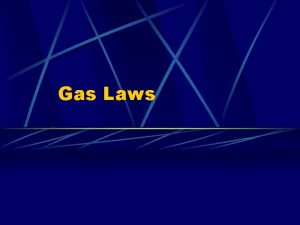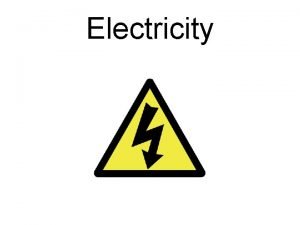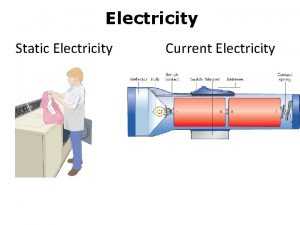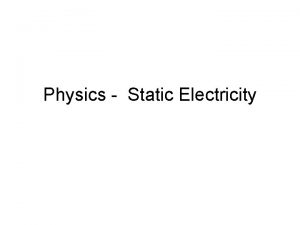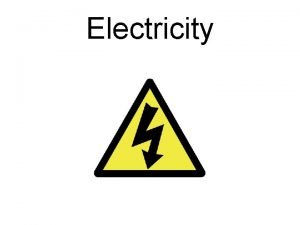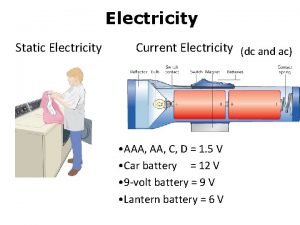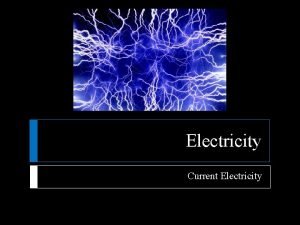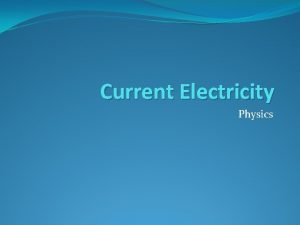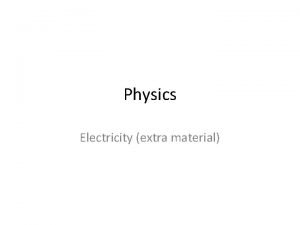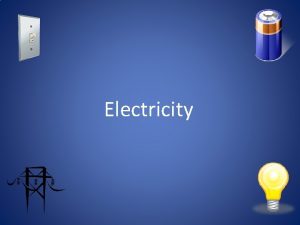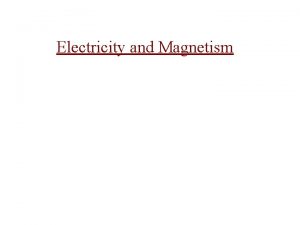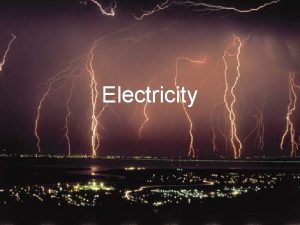KEY ELEMENTS PHYSICAL SCI ENCE Characteristics of Electricity












































- Slides: 44

KEY ELEMENTS: PHYSICAL SCI ENCE Characteristics of Electricity (22‐ 25 hours) Vocabulary acetate, amperes, coulombs, current, electric force, electrons, energy, joules, kilowatt∙hour s, ohms, Ohm’s Law, power, resistance, series and parallel circuits, static charge, Van de Graaff generator, voltage, volts Knowledge • static electrical charges • relationships between charged objects • electricity • movement of charged particles • electric current • resistance and voltage • Ohm’s Law • series and parallel circuits • power and energy consumption Skills and Attitudes • measure voltage and current using appropriate equipment • perform calculations • draw circuit diagrams

8. 1 ELECTRIC POTENTIAL ENERGY Chapter 8. 1 – pp. 270 -274

8. 1 ELECTRIC POTENTIAL ENERGY • Potential energy is stored energy that has the potential to make something move or change • Compressing a spring will store energy in the spring that can be released later, to make something move or change • Static electricity involves charges that build up and stay in the same place on an object. How can you store the charges to use later?

8. 1 ELECTRIC POTENTIAL ENERGY • A battery is a device that stores the energy of electric charges so that it can be used at some later time to do work • A battery is a source of electric potential energy • Batteries that convert chemical energy to electrical energy are called electrochemical cells • Connecting batteries to an electric motor or a light bulb lets the electrons move and do work

8. 1 ELECTRIC POTENTIAL ENERGY • Voltage = the amount of potential energy stored in a single coulomb of charge • The unit used to measure voltage is the volt, abbreviated V, in honour of Alessandro Volta, the scientist who invented the battery • The higher the voltage, the more work the electrons can do

8. 1 ELECTRIC POTENTIAL ENERGY How does a battery provide energy? • A battery provides energy to push negative charges through conductors that are connected together • Electrodes in an electrolyte chemically react to produce electrons and relatively different charges on each electrode. This creates a potential difference


8. 1 ELECTRIC POTENTIAL ENERGY

8. 1 ELECTRIC POTENTIAL ENERGY

8. 1 ELECTRIC POTENTIAL ENERGY

8. 1 ELECTRIC POTENTIAL ENERGY Other examples of electrical energy sources • Friction, produces static electricity, by separating charges • Piezoelectric crystals, when squeezed, separates positive and negative charges on opposite sides of the crystal

8. 1 ELECTRIC POTENTIAL ENERGY Other examples of electrical energy sources (cont’d) • Photoelectric cells, made of silicon, separates charges, when light hits them • Thermocouples, are devices made of two different metals, and they separate charges when one end is heated or cooled

8. 1 ELECTRIC POTENTIAL ENERGY Other examples of electrical energy sources (cont’d) • Generators, like the ones inside Hydroelectric Dams or Windmills, use the movement of a wire in a magnetic field to create a voltage

8. 1 ELECTRIC POTENTIAL ENERGY Potential Energy and Potential Difference • The potential energy of a something depends on how much charge (coulombs) has been separated, and the amount of potential difference (volts) • The potential energy is measured in units called Joules • Potential difference (volts) is like the height of a flight of stairs • The amount of charge (coulombs) is like how much mass goes up those stairs

8. 1 ELECTRIC POTENTIAL ENERGY A B

8. 1 ELECTRIC POTENTIAL ENERGY

8. 1 ELECTRIC POTENTIAL ENERGY

8. 1 ELECTRIC POTENTIAL ENERGY

8. 2 ELECTRIC CURRENT Chapter 8. 2 – pp. 280 -284 Insert: humourous sketch of electric current (find one first)

8. 2 ELECTRIC CURRENT • remember that a static electrical charge is one which stays in one place on an insulator • current electricity flows continuously within conductors from one place to another

8. 2 ELECTRIC CURRENT • Current = the amount of charge passing through a conductor every second • Current is measured in amperes (abbreviated A) after André-Marie Ampère who discovered the relationship between electricity and magnetism • 1 A = 1 coulomb per second

8. 2 ELECTRIC CURRENT • A complete pathway that allows electrons to flow is called an electric circuit. • Electrons flow through devices (loads) in the circuit that convert electricity to other forms of energy

1. slider builds up potential energy by climbing the stairs (electron charge is separated in a battery, generator, etc.

2. slider now has potential energy equal to the height of the stairs (electron has energy equal to the voltage)

3. slider walks without changing potential energy (electron moves through conductors like wires)

4. slider’s potential energy changes to other kinds of energy as he slides (electrons passing through a load)

5. slider now has no potential energy and must reclimb the stairs (electron must be reseparated in a battery)

8. 2 ELECTRIC CURRENT Basic Circuit Components -vocabulary • Source: source of energy (battery, cell, photocell, generator, etc. ) • Conductor: wire where current flows • Load: turns electricity into other forms (light bulb, resistor, electric motor, etc. ) • Switch: turns circuit on or off • To make measurements, voltmeters (for voltage) and ammeters (for current) can also be added

8. 2 ELECTRIC CURRENT A ammeter

8. 2 ELECTRIC CURRENT • The continuous flow of charge in a complete circuit is called current electricity. Electric current is defined as the amount of charge passing a point in a conductor every second. • Current is measured in amperes (A), and can be detected with an ammeter. • The flow of electricity is from negative to positive. In early electricity research, scientists mistakenly believed electricity flowed from positive to negative. Descriptions of this flow from positive to negative still exists today, and is known as conventional current.

8. 2 DRAWING CIRCUIT DIAGRAMS Follow these simple rules: • always draw diagrams with a ruler • conductors and wires should be straight lines, with 90° (right angle) corners • conductors should cross over each unless they are connected

PRACTICE Produce a circuit diagram of the following:

8. 2 ELECTRIC CURRENT

8. 2 ELECTRIC CURRENT

8. 3 RESISTANCE AND OHM’S LAW Chapter 8. 3 – pp. 290 -297

8. 3 RESISTANCE AND OHM’S LAW • Resistance is the property of any material that slows down the flow of electrons. • Resistance changes electrical energy into other forms (heat, light, motion, sound etc. ) Ohm’s Law • The bigger the amount of resistance, the smaller the current • Resistance = Voltage ÷ Current • Unit of resistance is the ohm (Ω)

8. 3 RESISTANCE AND OHM’S LAW Georg Simon Ohm A high school teacher, Ohm began his research with the new electrochemical cell, invented by scientist Alessandro Volta. Ohm found a equation for the voltage across a conductor and the electric current going through the conductor. The equation is Ohm’s Law

8. 3 OHM’S LAW Voltage = Current x Resistance I = V / R I V = I x R V V R I V / I = R V R I R Link: PHet- Ohm’s Law

8. 3 RESISTANCE AND OHM’S LAW link: Phet Light Bulb Ohms (Ω) Ammeter Amps (A) ` Battery Volts (V) I = V / R A V = I x R V / I = R

8. 3 RESISTANCE AND OHM’S LAW Light Bulb Ohms (Ω) ` ` Ammeter Amps (A) Battery Volts (V) I = V / R A V = I x R V / I = R

8. 3 RESISTANCE AND OHM’S LAW Light Bulb Ohms (Ω) ` ` Battery Volts (V) Ammeter Amps (A) Light Bulb Ohms (Ω) A ` I = V / R V = I x R V / I = R

8. 3 RESISTANCE AND OHM’S LAW Voltage = 6. 0 Volts Light Bulb , 3. 0 Ohms Current = ______Amps Equation Numbers Answer

8. 3 RESISTANCE AND OHM’S LAW Voltage = _____Volts Light Bulb , 4. 0 Ohms Current = 0. 5 Amps Equation Numbers Answer

8. 3 RESISTANCE AND OHM’S LAW
 Static electricity and current electricity
Static electricity and current electricity Static electricity and current electricity
Static electricity and current electricity Electricity and magnetism vocabulary
Electricity and magnetism vocabulary Aaawwubbis
Aaawwubbis Simple sentence notes
Simple sentence notes Sent interrupter ence example
Sent interrupter ence example Ence electric
Ence electric Ence storage
Ence storage Ence360
Ence360 Easy for ence
Easy for ence Science fiction characteristics
Science fiction characteristics Three elements of electricity
Three elements of electricity Key partners example business model canvas
Key partners example business model canvas Contoh bisnis model canvas makanan pdf
Contoh bisnis model canvas makanan pdf Umass poli sci
Umass poli sci Sci technology work from home
Sci technology work from home Sci auditoria
Sci auditoria Spi vs sci
Spi vs sci Sci gateway
Sci gateway Sci borg
Sci borg Recursion ap csa
Recursion ap csa Math sci
Math sci Eecs 110
Eecs 110 Comp sci 1102
Comp sci 1102 Cog sci 131
Cog sci 131 Sci-fi conventions examples
Sci-fi conventions examples Guerilla open access
Guerilla open access Sci communication
Sci communication Znaky scifi
Znaky scifi Sci first for hunters
Sci first for hunters Scala panss
Scala panss Risolvere problemi con equazioni
Risolvere problemi con equazioni For offical use only
For offical use only Sci verse
Sci verse Si prefix chart
Si prefix chart Variabili invariabili difettivi sovrabbondanti
Variabili invariabili difettivi sovrabbondanti Comp sci 1027
Comp sci 1027 Sci-elo
Sci-elo Phil sci
Phil sci Scims definition
Scims definition Chalecos sistema comando de incidentes
Chalecos sistema comando de incidentes Sci
Sci Sci
Sci Encv
Encv Stranger things gener
Stranger things gener



